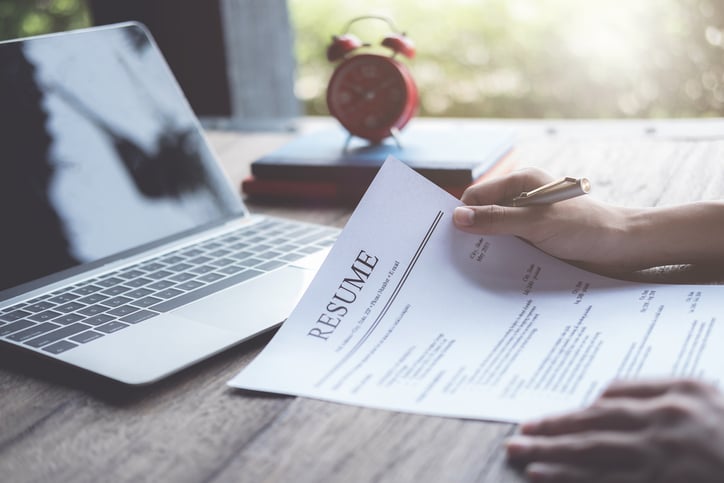How to create a LinkedIn profile for job search
July 7, 2020
- Home
- Blog

Source: DenPhotos/Shutterstock
Your LinkedIn profile page works just like an online resume. It gives you the opportunity to showcase your skills and experiences, and you can also browse for jobs on the site. In fact, 90% of recruiters regularly use LinkedIn to look for candidates.
If you’re looking for a new role, optimising your LinkedIn profile is a great way to get your resume out there.
Check out the video below with a few tips and tricks that we've selected for you:
How to build a personal brand?
Establishing a strong personal brand has become an indispensable step in the modern professional world, particularly in the digital sphere. Your personal brand is a reflection of your unique skills, experiences, and values; it is the narrative that sets you apart from your competitors, making you more than just a name on a resume.
An effective personal brand provides you with a platform to convey your professional story, showcasing your expertise and enhancing your visibility within your industry.
Furthermore, a compelling personal brand fosters trust and credibility, enabling you to establish more meaningful relationships with peers, clients, and potential employers. Especially in today's LinkedIn-dominated professional ecosystem, a powerful personal brand can serve as a key to unlocking invaluable opportunities.
Hence, whether you're a budding professional or an established leader, curating your personal brand should be viewed not as an option, but rather as an essential strategy for career growth and success and LinkedIn is a great tool to do that.
So how do you edit your profile to stand out from the crowd?
We’ve put together a list of LinkedIn profile tips to help you find your next job role:
Step 1: Select a profile picture
Your profile picture is your first chance to grab potential employers’ attention when viewing your profile. Having a profile picture makes your profile more personable and makes you appear more approachable.
Your LinkedIn page should feature a more professional image than other social media sites. This is especially important if you’re applying for jobs and want to attract recruiters.
If you have one, you can use a professional headshot from your current place of employment. But don’t worry if you don’t. There are a number of ways to produce professional photos in your home:
- Wear clothes you’d wear for a job interview
- Stand in front of a plain background with as few visual distractions as possible
- Make sure the picture is taken with good lighting - natural lighting is best if possible!
- Selfies are okay if the angle is straight on and your arm isn’t visible in the photo. However, for better results, ask someone else to take the photo for you
Step 2: Add your location
When you’re creating your profile, be sure to add an accurate location, including your country and zip code or postcode. This makes your profile searchable for employers, recruiters and people interested in networking with you.
Uploading your specific location will also help LinkedIn curate jobs that are local to you. You’ll also get notifications with news and articles that are trending in your area.
Step 3: Include your contact information
Having contact information such as your email address on your profile is highly beneficial if you’re job-hunting. It means employers and recruiters interested in speaking to you will have a way of getting in touch with you directly.
LinkedIn also allows you to discreetly set your profile status as ‘open to new opportunities’. This means that recruiters know you’re looking for a job when they find you in search results. You can select this option under ‘LinkedIn preferences’.
Step 4: Provide detailed experience and list your skills

The work experience section of your LinkedIn profile works in the same way as a traditional resume. However, there’s more space to expand on each position.
Detailing your job duties for each role you’ve had helps hiring managers and recruiters match you to the perfect job. When you explain your core responsibilities, try to include search optimized keywords that are specific to the job and your skills. This will help you to appear higher up in LinkedIn search results.
Including your skills will let recruiters know what you’re good at. It will also help them to find you when conducting a candidate search using the relevant key terms.
We also recommend including your accomplishments alongside your skills and, where possible, include measurable results to back them up. For example, if analytical thinking is one of your skills, mention specific ways you’ve used this skill in practice.
Finally, make sure you add accurate information to your headline. Most recruiters will be using keywords such as job titles to find candidates for their roles. However, many job seekers put ‘seeking opportunities’ in their headline.
Recruiters won’t be searching for such broad terms, so using this technique could actually lower your chances of being found. Instead, always include your current job title.
Step 5: Customize your URL
The default URL that comes with your LinkedIn account consists of your name and a string of numbers and letters. This URL is quite clunky and difficult to share with people.
Having a customized URL makes it much easier for recruiters and employers to search for you. You can do this from LinkedIn’s Public Profile Settings page. From here, you can create a personalized URL that just includes your name, e.g. linkedin.com/in/john-smith.
Your personalized URL will be easier to remember and looks much cleaner when printed on your resume.
Step 6: Write a summary
Your LinkedIn profile summary section appears below your profile photo, name and headline. Writing a summary is a great way to showcase your skills and state why they matter. This is your chance to really market yourself, so make sure your summary is personable and attractive to recruiters.
You have 2,000 characters to use in your profile summary. Don’t be afraid to include as many industry-specific keywords as possible. Just make sure it isn’t too spammy! This will help you to appear higher in LinkedIn searches by recruiters.
We recommend analyzing the job descriptions of positions you’re interested in to see which keywords crop up. You can then use these keywords and phrases to highlight your hard skills whilst also attracting recruiters and hiring managers. You can present this information in bullet points, as you might in your resume summary.
Step 7: Connect with other professionals
As well as being a professional profile, LinkedIn is very useful for keeping in touch with your colleagues and teammates. The bigger your network of connections, the more likely you are to get discovered by employers and recruiters. This is especially true if you share relevant content on your account (we’ll come to this in a moment).
Growing your connections widens your network and helps you to establish yourself as an expert in your field. It also gives you more exposure and helps to validate your position and status in your field of expertise.
Step 8: Share information

Sharing relevant information, such as blogs and studies, on your LinkedIn page adds value to your profile. It shows potential employers how you engage professionally.
If you publish valuable content on LinkedIn, it can strengthen your position as an authority on that topic. Posting regularly will help you to create trust among your connections. It also helps you to be seen as an expert on the topic you’re posting about.
Step 9: Upload your resume and complete your profile
You can upload your resume to LinkedIn. This offers another opportunity to share important information about your career with recruiters and headhunters.
For more tips on finding a job, check out our jobseekers' guide.
Let Airswift help you in your job search!
Ready to find your next role? Let Airswift help! Visit our job board to browse our current vacancies.

This post was written by: Paula Clarkson, Global Recruiter at Airswift, and Laiz Silva, Strategic Delivery Consultant
You may also be interested in…
-
Top petrochemicals employment trends to look out for in 2024
-
How to conduct an effective job search
-
How to overcome global payment processing challenges
-
Refining the US petrochemical talent pipeline
-
The Airswift commitment to CSR
-
10 Tips for using social media in your job search
-
Resume writing tips - how can job seekers stand out?
-
Going green: attracting and retaining talent
-
Top tips to elevate your company’s recruitment strategy
-
The Great Crew Change: Bridging the skills gap in engineering

